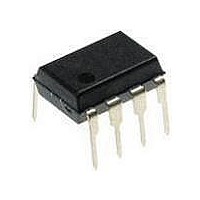CAT1163P-28 Catalyst / ON Semiconductor, CAT1163P-28 Datasheet - Page 7

CAT1163P-28
Manufacturer Part Number
CAT1163P-28
Description
Supervisory Circuits 16K I2C Memory w/WDT
Manufacturer
Catalyst / ON Semiconductor
Datasheet
1.CAT1163WI-30-T3.pdf
(14 pages)
Specifications of CAT1163P-28
Number Of Voltages Monitored
1
Monitored Voltage
3 V, 3.3 V, 5 V
Output Type
Active High, Active Low, Open Drain
Manual Reset
Resettable
Watchdog
Watchdog
Battery Backup Switching
No Backup
Supply Voltage (max)
6 V
Supply Voltage (min)
2.7 V
Supply Current (typ)
3000 uA
Maximum Power Dissipation
1000 mW
Maximum Operating Temperature
+ 70 C
Mounting Style
Through Hole
Package / Case
PDIP-8
Minimum Operating Temperature
0 C
Power Fail Detection
No
Undervoltage Threshold
2.85 V
Overvoltage Threshold
3 V
Lead Free Status / Rohs Status
Lead free / RoHS Compliant
FUNCTIONAL DESCRIPTION
The CAT1163 supports the I
sion protocol. This Inter-Integrated Circuit Bus proto–
col defines any device that sends data to the bus to
be a transmitter and any device receiving data to be a
receiver. The transfer is controlled by the Master
device which generates the serial clock and all
START and STOP conditions for bus access. Both the
Master device and Slave device can operate as either
transmitter or receiver, but the Master device controls
which mode is activated.
I
The features of the I
follows:
(1) Data transfer may be initiated only when the bus
(2) During a data transfer, the data line must remain
START Condition
The START Condition precedes all commands to the
device, and is defined as a HIGH to LOW transition of
SDA when SCL is HIGH. The CAT1163 monitors the
SDA and SCL lines and will not respond until this
condition is met.
Figure 5. Acknowledge Timing
Figure 6. Slave Address Bits
*a8, a9 and a10 correspond to the address of the memory array address word.
© 2009 SCILLC. All rights reserved.
Characteristics subject to change without notice
2
C Bus Protocol
is not busy.
stable whenever the clock line is high. Any
changes in the data line while the clock line is
high will be interpreted as a START or STOP
condition.
FROM TRANSMITTER
FROM RECEIVER
2
DATA OUTPUT
DATA OUTPUT
C bus protocol are defined as
SCL FROM
MASTER
2
CAT1163
C Bus data transmis–
START
1
0
1
1
7
0
STOP Condition
A LOW to HIGH transition of SDA when SCL is HIGH
determines the STOP condition. All operations must
end with a STOP condition.
Device Addressing
The Master begins a transmission by sending a
START condition. The Master sends the address of
the particular slave device it is requesting. The four
most significant bits of the 8-bit slave address are
fixed as 1010.
The next three bits (Figure 6) define memory
addressing. For the CAT1163 the three bits define
higher order bits.
The last bit of the slave address specifies whether a
Read or Write operation is to be performed. When this
bit is set to 1, a Read operation is selected, and when
set to 0, a Write operation is selected.
After the Master sends a START condition and the
slave address byte, the CAT1163 monitors the bus
and responds with an acknowledge (on the SDA line)
when its address matches the transmitted slave
address. The CAT1163 then performs a Read or Write
operation depending on the R/W ¯ ¯ bit.
a10
a9
8
a8
ACKNOWLEDGE
R/W ¯ ¯
9
Doc. No. MD-3003 Rev. I
CAT1163
















